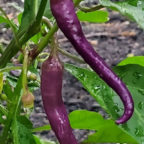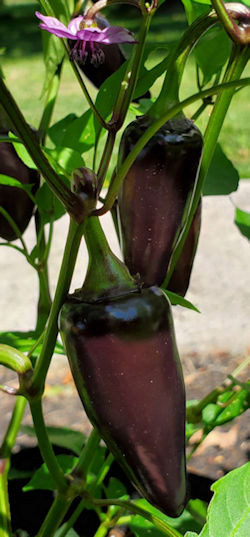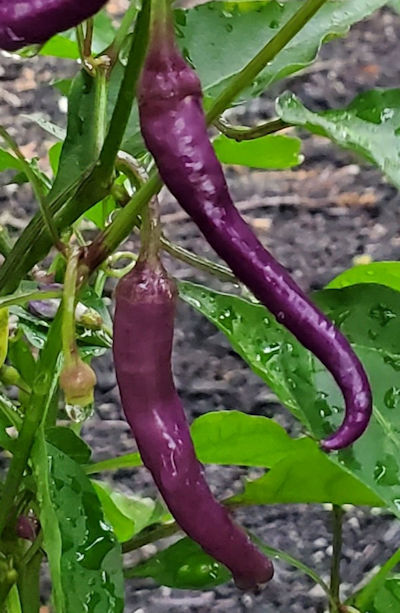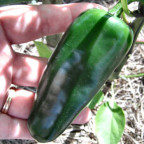Harvesting Peppers – Picking Purple Peppers
Harvesting peppers has started with a bang this Summer 2020 season. I’ve harvested a few in the past couple of weeks, but now the peppers have started growing in earnest. And picking my purple peppers looks to be next on the agenda!
Purple Jalapeno Pepper
Jalapenos are among the easiest peppers to grow (at least for me). Although I am growing two types of jalapenos this year (Purple Jalapeno and Tricked You), it’s the Purple Jalapeno chili pepper that is clearly leading the way.
It’s June 26th and I’ve picked about five jalapenos from the plant, and I think I have at least 10 more peppers waiting to be harvested. The plant is only about 20 inches tall, and it just keeps flowering and setting fruit with abandon. I am seriously glad that I only planted one of these, because it will provide a ton before the fall frosts show up.
I’m growing Purple Jalapeno in a 3-gallon fabric pot. I’m trying to remember to give my peppers a light fertilizer feeding every other week (since they are in containers) but I probably missed a week or two. In other words — no special treatment.
Purple Jalapeno is an open pollinated pepper variety. I can save seeds from one of the peppers, and I’ll get more of the same next year.
Buena Mulata Peppers
Buena Mulata is a cayenne-type chile pepper that, if possible, is even more prolific than Purple Jalapeno! The plant is only about 18 inches tall and I’ve picked about seven chili peppers so far. I easily have 15 more waiting on the plant!
I’ll pick a few more soon (just to keep the peppers coming), but I want to leave some on the plant for a bit to ripen to red. I decided to grow Buena Mulata for the chili peppers, but this variety can very easily double as an ornamental pepper plant.
Just like Purple Jalapeno, Buena Mulata is open-pollinated and is growing in a 3-gallon fabric pot. For that matter, they are actually growing side-by-side. 😀
Picking Purple Peppers
I started picking purple peppers early this month (June). To be honest, the peppers have not been very spicy yet. Why not?
Part of the reason is that it hasn’t been that warm yet here in East Tennessee. While we’ve had one or two days around 90 so far, most of the days have been in the mid 80s. We had a cool April and May, so the peppers haven’t had the opportunity to “chile up” and get spicy. But, as we get more into the hotter days of summer, the peppers will start turning their own heat up.
In addition, as they ripen to their final color (in both cases the color is red), the hotter they become.
I’ll be doing a harvest video soon, with not only these two chile pepper varieties but also some others. I’ll post the link here as soon as I have it posted.
Meanwhile, feel free to wander around the site and enjoy the info (and the peppers). See you soon!
Peppers Planned for 2020
It’s pepper seed time! I decided that I would go the “all seed” route for the 2020 growing season. Although I probably won’t be doing any actual planting of seeds for several more weeks, I have all my seeds ordered. So what’s in store for 2020 in my new location?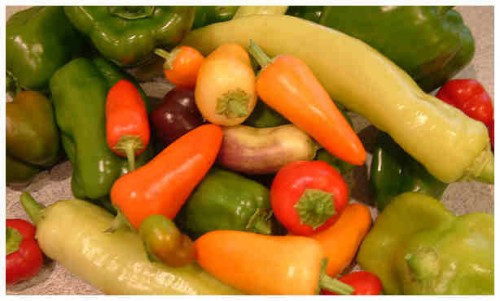
Hot Cha Cha!
I don’t have any super-hot peppers planned for this year, but I do have some hot ones ordered! Here’s the hot pepper seeds on the way:
- Purple Jalapeno:Â Seeing as I am also growing a non-heat jalapeno, I wanted to make my spicy jalapeno a different color so I could tell the two apart.
- Bolivian Rainbow:  I grew this many years ago, then had a hard time finding it again. Success! This is mostly ornamental, but the peppers are definitely edible and quite hot. I love the way these peppers have multiple colors of peppers on the bush all at once.
- Buena Mulata: Another purple pepper. This one is more like a cayenne pepper, and about the same heat.
- Tricked You Jalapeno: This is the no-heat jalapeno. I tried to grow the “Fooled You” a few years back, and I guess this one is the newer version.
- Numex Suave Orange: Supposedly a no-heat habanero. I am not sure that every pepper will be no-heat, so I will be careful when tasting the peppers.
- Aji de Sazonar: Another no-heat pepper, this time more like a serrano in shape. Supposed to be great for drying and grinding into a seasoning powder.
- Tobago Seasoning: A no-heat scotch bonnet pepper. Again, not sure that the heat will be absent from all peppers, but I imagine that the seeds and membranes will be what’s really hot.
A few more of the non-heat hot peppers than is usual for me, bit it will be really interesting to see how “no heat” the no heat peppers will be. Hmmm, now that I have all these listed out, I may hold off on either the Numex Suave Orange or the Tobago Seasoning until next year.
Cool It!
As to the sweet peppers, here’s the run-down:
- Chilly Chilli: Just an ornamental pepper. I seem to recall I tried this a few years back and didn’t have any luck, but I wanted a low-ish growing ornamental pepper that was safe to brush up against (i.e., no hot oils getting on my hands or clothes).
- Yum Yum Mix:Â Mini bell peppers, kind of like the ones I’ve been seeing pop up in the grocery stores lately.
- Sweet Pickle: Another ornamental, a lot like Bolivian Rainbow, but with a slightly larger pepper. This one is like Chilly Chilli, supposed to be safe to brush up against, etc.
- Petit Marseillais: Something like a cross between a bell pepper and a frying pepper, but more like the bell. Supposed to be very sweet.
- Roumanian Sweet: This is a bell pepper. I grew it many years ago, it changes color from a pale greenish-white to purple to orange and then red. It was quite tasty.
All in all, this should be an interesting year for peppers.
Planting Seeds
I have a couple new seed sprouting things I want to trial, so that post will be coming up (actually, probably more like a series of posts).
How Long Do Pepper Plants Live – Update
How long do pepper plants live — really? In the years since my original post, I’ve come to think somewhat differently about this interesting plant and its fruit. And while I don’t know that I will be able to speak to bell peppers, I think I will be able to talk about sweet and chile peppers.
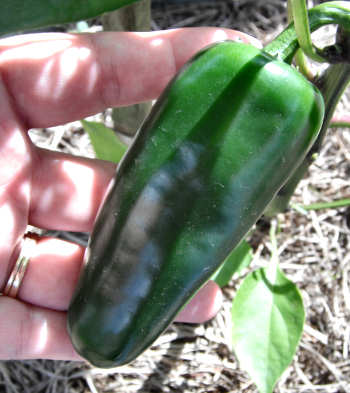 (The reason I can’t speak to bell peppers is that to date, I’ve never had one last very long. I have bad bell karma, I guess.) ;) However, those who have better luck with bells may be able to relate to what I’ve discovered.
(The reason I can’t speak to bell peppers is that to date, I’ve never had one last very long. I have bad bell karma, I guess.) ;) However, those who have better luck with bells may be able to relate to what I’ve discovered.
Getting in the Zone
How long your particular pepper plants live is dependent upon what plant hardiness zone you live in. Peppers are really warm-weather plants, and they can’t handle frost and freezes. If you live in zones, say, 8b to 11, you can probably overwinter your peppers outside. You may need some frost protection from time to time, but if you can do that, it’s a possibility.
North of 8b, you’ll have to overwinter your plants in containers inside. If you have a heated greenhouse, that’s the best option. Otherwise, inside with grow lights is what you’ll need to do.
Why Bother Keeping a Plant Alive?
Good question! Typically, I don’t bother with “everyday” plants — those peppers that I can easily grow from seeds or find at a local big box store. However, a plant that is harder to replace, or one that has produced extraordinarily for you, may be a candidate for keeping alive.
For example, I really enjoy the Fooled You jalapeno pepper that I grew a couple years back. It’s a hybrid, so I can’t really save the seeds. This time, if one of my plants (I have three seedlings) is outstanding, I am going to try to keep it going.
Preparing Your Pepper Plants
How do you prepare your peppers? Be prepared for some “tough love” in order to overwinter.
If you can routinely expect more than two or three freezes in a winter, you’ll need to uproot your pepper and put it in a container you can manage to move around; probably between a 3 to 5 gallon container. If you are already container growing and can move the container inside, you’re a step ahead. If you’re digging the plant up from the ground, you will need a container ready, along with some loose but rich soil ready.
You’ll have to do the uprooting carefully. If your plant is big an unwieldy, you may want to lightly prune – enough so that you can easily handle the plant. Use a shovel to dig in a circle around the plant, starting about a foot away from the stem.
Once your have the plant dug up, gently shake the soil from the roots. Depending on the size of the roots, you may need to lightly trim them back with a sharp pair of scissors. (Or, use a larger container.)
Put some of the prepared soil into the container to about 1/3 the depth. Put the plant into the container and back fill with more soil. Give the plant a light watering, and place it where it can get some morning sun — you don’t want to give it too much sun until it’s settled into the container some.
Clip! Snip!
A few days after your transplanting, or, even if your pepper plant is already in a container, it will need a haircut. Why?
The light available to your plants in Winter is much less than in any other season (in the northern hemisphere, anyway). Inside, your pepper plant will get even less light, unless you have a very bright grow room. Your pepper plant will need fewer leaves to support while it’s in a lower-light and cooler environment.
How far back should you prune? Half its height is a good place to start. I’ll have a post about pruning peppers in the near future; I’ll link to it when I have it ready.
Food and Water
During its overwintering, your pepper will need less water — let the soil dry out between waterings. As far as food goes, you will only need to fertilize rarely, with a low-strength solution. I would say to use fish fertilizer, but only if your are over-wintering outdoors — it would smell a bit much in the house.  😉
Light and Warmth
As you might guess, your pepper plant will need as much light and warmth as you can manage, once it’s acclimated to its re-potting and pruning. Your pepper will appreciate temperatures in the low 70s, and still would like 6 hours of direct sun. Since that may not be possible unless you have a greenhouse, you will probably need to supplement with some plant grow lights.
But Really — How Long Do Pepper Plants Live?
In containers, you may be able to keep a plant going for several years. In-ground (if you are in zone 10 or 11), it could be indefinitely. In any case, you will need to decide how long your want to keep your pepper plant going, and that may depend on how well it keeps producing.
Hope this has helped some!
